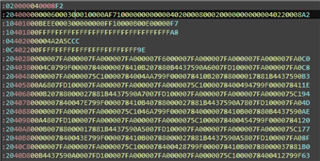Tool/software:
I suspect I have an issue in my linker that is causing address overlap in the resulting Intel Hex file. I have attached linker as reference. I'm having data overlap at address 0x84010 on line 3

CLA_SCRATCHPAD_SIZE = 0x100;
--undef_sym=__cla_scratchpad_end
--undef_sym=__cla_scratchpad_start
MEMORY
{
/* BEGIN is used for the "boot to Flash" bootloader mode */
BOOT_RSVD : origin = 0x000002, length = 0x0001AF /* Part of M0, BOOT rom will use this for stack */
RAMM0 : origin = 0x0001B1, length = 0x00024F
RAMM1 : origin = 0x000400, length = 0x0003F8 /* on-chip RAM block M1 */
RAMD0 : origin = 0x00C000, length = 0x000800
RAMD1 : origin = 0x00C800, length = 0x000800
RAMLS0_3 : origin = 0x008000, length = 0x002000 // RAMLS0, RAMLS0LS1, RAMLS0LS2 and RAMLS3 are combined and used as CLA program memory
RAMLS4_7 : origin = 0x00A000, length = 0x002000 // RAMLS4, RAMLS0LS5, RAMLS0LS6 and RAMLS7 are combined and used as CLA data memory
RAMGS0_1 : origin = 0x00D000, length = 0x002000
RAMGS2_7 : origin = 0x00F000, length = 0x005FFB
RAMGS8 : origin = 0x015000, length = 0x001000
RAMGS9 : origin = 0x016000, length = 0x001000
RAMGS10_11 : origin = 0x017000, length = 0x002000
RAMGS12 : origin = 0x019000, length = 0x001000
RAMGS13 : origin = 0x01A000, length = 0x001000
RAMGS14_15 : origin = 0x01B000, length = 0x001FF8 //RAMGS14, RAMGS15 are combined and used as a ram function for faster execution
FW_FILE_SIZE : origin = 0x014FFB, length = 0x000004
RUN_BL_MARKER : origin = 0x014FFF, length = 0x000001
/* Flash sectors */
GROUP { /* GROUP memory ranges for crc/checksum of entire flash */
BEGIN : origin = 0x084020, length = 0x000002, fill=0xFFFF
FLASH2_13 : origin = 0x084022, length = 0x03BEEE, fill=0xFFFF /* on-chip Flash - FLASH2 to FLASH13 are combined */
NV_DATA : origin = 0x0BFF10, length = 0x0000E0, fill=0xFFFF /* for storing nv data */
} crc(_ccs_flash_checksum, algorithm=CRC16_802_15_4)
CRC_DATA : origin = 0x84000, length = 0x000020, fill=0xFFFF /* for storing auto generated crc */
CPU1TOCPU2RAM : origin = 0x03A000, length = 0x000800
CPU2TOCPU1RAM : origin = 0x03B000, length = 0x000800
CPUTOCMRAM : origin = 0x039000, length = 0x000800
CMTOCPURAM : origin = 0x038000, length = 0x000800
CANA_MSG_RAM : origin = 0x049000, length = 0x000800
CANB_MSG_RAM : origin = 0x04B000, length = 0x000800
RESET : origin = 0x3FFFC0, length = 0x000002
CLA1_MSGRAMLOW : origin = 0x001480, length = 0x000080
CLA1_MSGRAMHIGH : origin = 0x001500, length = 0x000080
CLA1_DMA_MSGRAM : origin = 0x001680, length = 0x000080
DMA_CLA1_MSGRAM : origin = 0x001700, length = 0x000080
}
SECTIONS
{
codestart : > BEGIN, ALIGN(8)
.text : >> FLASH2_13, ALIGN(8)
.cinit : > FLASH2_13, ALIGN(8)
.switch : > FLASH2_13, ALIGN(8)
.reset : > RESET, TYPE = DSECT /* not used */
.stack : > RAMM1
.freertosStaticStack: >> RAMGS0_1
.freertosHeap : > RAMGS13
#if defined(__TI_EABI__)
.init_array : > FLASH2_13, ALIGN(8)
.bss : > RAMGS2_7
.bss:output : > RAMGS8
.data : > RAMGS10_11
.sysmem : > RAMGS9
/* Initalized sections go in Flash */
.const : > FLASH2_13, ALIGN(8)
#else
.pinit : > FLASH2_13, ALIGN(8)
.ebss : > RAMGS2_7
.esysmem : > RAMGS9
/* Initalized sections go in Flash */
.econst : >> FLASH2_13, ALIGN(8)
#endif
MSGRAM_CPU1_TO_CPU2 : > CPU1TOCPU2RAM, type=NOINIT
MSGRAM_CPU2_TO_CPU1 : > CPU2TOCPU1RAM, type=NOINIT
MSGRAM_CPU_TO_CM : > CPUTOCMRAM, type=NOINIT
MSGRAM_CM_TO_CPU : > CMTOCPURAM, type=NOINIT
RUN_BL_MARKER_LOCATION : > RUN_BL_MARKER, type=NOINIT
FW_FILE_SIZE_LOCATION : > FW_FILE_SIZE, type=NOINIT
dclfuncs : > FLASH2_13, ALIGN(8)
/* CLA specific sections */
#if defined(__TI_EABI__)
Cla1Prog : LOAD = FLASH2_13,
RUN = RAMLS0_3,
LOAD_START(Cla1funcsLoadStart),
LOAD_END(Cla1funcsLoadEnd),
RUN_START(Cla1funcsRunStart),
LOAD_SIZE(Cla1funcsLoadSize),
ALIGN(8)
#else
Cla1Prog : LOAD = FLASH2_13,
RUN = RAMLS0_3,
LOAD_START(_Cla1funcsLoadStart),
LOAD_END(_Cla1funcsLoadEnd),
RUN_START(_Cla1funcsRunStart),
LOAD_SIZE(_Cla1funcsLoadSize),
ALIGN(8)
#endif
CLADataLS0 : > RAMLS4_7
CLADataLS1 : > RAMLS4_7
Cla1ToCpuMsgRAM : > CLA1_MSGRAMLOW, type=NOINIT
CpuToCla1MsgRAM : > CLA1_MSGRAMHIGH, type=NOINIT
Cla1ToDmaMsgRAM : > CLA1_DMA_MSGRAM, type=NOINIT
DmaToCla1MsgRAM : > DMA_CLA1_MSGRAM, type=NOINIT
Cla1DataRam : > RAMLS4_7
/* CLA C compiler sections */
//
// Must be allocated to memory the CLA has write access to
//
CLAscratch :
{ *.obj(CLAscratch)
. += CLA_SCRATCHPAD_SIZE;
*.obj(CLAscratch_end) } > RAMLS4_7
.scratchpad : > RAMLS4_7
.bss_cla : > RAMLS4_7
cla_shared : > RAMLS4_7
#if defined(__TI_EABI__)
.const_cla : LOAD = FLASH2_13,
RUN = RAMLS0_3,
RUN_START(Cla1ConstRunStart),
LOAD_START(Cla1ConstLoadStart),
LOAD_SIZE(Cla1ConstLoadSize)
#else
.const_cla : LOAD = FLASH2_13,
RUN = RAMLS0_3,
RUN_START(_Cla1ConstRunStart),
LOAD_START(_Cla1ConstLoadStart),
LOAD_SIZE(_Cla1ConstLoadSize)
#endif
NV_DATA_Location : > NV_DATA
.TI.memcrc : > CRC_DATA
#if defined(__TI_EABI__)
.TI.ramfunc : {} LOAD = FLASH2_13,
RUN = RAMGS14_15,
LOAD_START(RamfuncsLoadStart),
LOAD_SIZE(RamfuncsLoadSize),
LOAD_END(RamfuncsLoadEnd),
RUN_START(RamfuncsRunStart),
RUN_SIZE(RamfuncsRunSize),
RUN_END(RamfuncsRunEnd),
ALIGN(8)
#else
.TI.ramfunc : {} LOAD = FLASH2_13,
RUN = RAMGS14_15,
LOAD_START(_RamfuncsLoadStart),
LOAD_SIZE(_RamfuncsLoadSize),
LOAD_END(_RamfuncsLoadEnd),
RUN_START(_RamfuncsRunStart),
RUN_SIZE(_RamfuncsRunSize),
RUN_END(_RamfuncsRunEnd),
ALIGN(8)
#endif
#if defined(__TI_EABI__)
IntProRam : LOAD = FLASH2_13,
RUN = RAMGS9,
LOAD_START(IntProgLoadStart),
LOAD_SIZE(IntProgLoadSize),
LOAD_END(IntProgLoadEnd),
RUN_START(IntProgRunStart),
RUN_SIZE(IntProgRunSize),
RUN_END(IntProgRunEnd),
ALIGN(8)
#else
IntProRam : LOAD = FLASH2_13,
RUN = RAMGS9,
LOAD_START(_IntProgLoadStart),
LOAD_SIZE(_IntProgLoadSize),
LOAD_END(_IntProgLoadEnd),
RUN_START(_IntProgRunStart),
RUN_SIZE(_IntProgRunSize),
RUN_END(_IntProgRunEnd),
ALIGN(8)
#endif
}
/*
//===========================================================================
// End of file.
//===========================================================================
*/
I suspect the following section is causing the overlap, being CRC_AREA the conflicting one. If the linker is placing CRC of the flash group into CRC_DATA, is there a possibility for the application to also write into this section, thus causing the conflict? Since the areas appear to be contiguous, and CRC_DATA is excluded from the group, I'm not 100% certain, so I'm asking for a second eye with more linker experience to point me the possible issue.
GROUP { /* GROUP memory ranges for crc/checksum of entire flash */
BEGIN : origin = 0x084020, length = 0x000002, fill=0xFFFF
FLASH2_13 : origin = 0x084022, length = 0x03BEEE, fill=0xFFFF /* on-chip Flash - FLASH2 to FLASH13 are combined */
NV_DATA : origin = 0x0BFF10, length = 0x0000E0, fill=0xFFFF /* for storing nv data */
} crc(_ccs_flash_checksum, algorithm=CRC16_802_15_4)
CRC_DATA : origin = 0x84000, length = 0x000020, fill=0xFFFF /* for storing auto generated crc */


